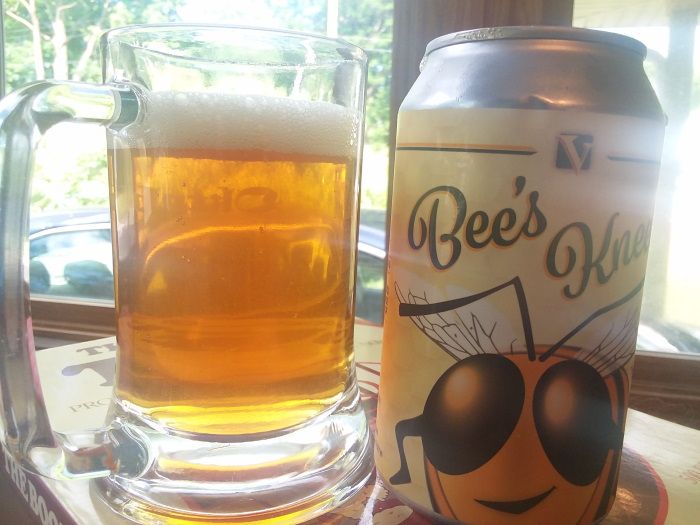The humble cream ale is really quite popular here in
Wisconsin despite the style not having an "I" or the word "India" in it. The taxonomic experts of the internet tell me that New Glarus' Spotted
Cow falls into the cream ale category and they sell a shit ton of that stuff. (I suppose this means that the cream ale is also popular in Illinois.) Having
read a bit about the style, I now realize just how apropos it is to describe Spotted Cow, as many do, as a kind of introductory craft beer for folks accustomed to American macro
lagers like Bud, Miller, and Coors. From what I've read, American brewers
developed the cream ale in the mid-19th century in reaction to the burgeoning
popularity of pilsners brewed by an increasing number of German immigrants and their kin.
Honestly, I had no idea that the cream ale is indigenous to
the United States although the thought would have occurred to me sooner or later had I bothered
to cogitate upon the matter for a while. Had I done so, I don't think it would
have taken too long for me to realize there isn't a Samuel Smith's Cream Ale nor a Bitburger
Sahne Obergäriges Lagerbier. The cream ale is a light beer generally brewed
with some corn or perhaps rice to help give the beer a light body just like American lagers. Being top fermented, it's an ale but cream ales are often lagered
so it's an ale because that's American brewing for you. Aging makes the fruity
flavors go away and you're left with a nice malt-hop balance.
On a recent trip to the liquor store, I opted for Bee's
Knees, a honey cream ale from Vintage Brewing here in Madison (and Sauk too). It is available
in cans as well as on tap at its various locations.
In addition to honey, there's also oats in Bee's Knees to further
the beer's retreat from the style's conventions as brewmaster Scott Manning
likes to mess with things because it is in his nature to do so.
I wish I knew more about honey to be able to give you some
more info like its variety, terroir, and whatnot but that is beyond me. This is
a shame because honey is in my blood. Back in the Middle Ages, Germans and Slavs led
the world in honey production and German and Slavic make up most of my ethnic
heritage.
Some interesting honey trivia: I am used to talking about and
eating foods that are native to the Americas and there are lots of tasty things
out there that I am privileged to eat only because Columbus got lost. E.g. –
maize, tomatoes, chilies, potatoes, etc. Rarely am I cognizant of the opposite situation but we have one right here. While there were honey bees in the
Americas when our intrepid explorer made landfall in the Bahamas, they did not
live in North America. The honey bees found to the south have, shall we say, more catholic
tastes in nectar than their European cousins. These bees are happy to collect
"nectar", so to speak, from sources most bees dare not tread such as corpses and poop. Their honey must be
quite extraordinary and has surely been eagerly gobbled up at one of those legendary
Explorers Club dinners, perhaps as part of a glaze to a wooly mammoth roast.
No doubt Vintage acquired their honey from a more mundane
source.
Honey was also the first thing that my tongue noticed – that
earthy vanilla kind of flavor. There was some malt along with a little corn but
it wasn't particularly sweet. All of this was complemented by a really nice herbal
hoppiness. There's a was a firm fizz to be had and I tasted a smoothness
underneath it which was likely from the oats. The hops took a turn towards the
peppery for the finish and left a little bitterness to go with some lingering
corn taste.
Despite Bee's Knees, as Neil Peart would have said,
deviating from the norm with oats and honey, it still had a medium-light
body with the oats adding a little something more to it. The barley, oats, corn, and hops were all in their proper places to create a balanced
flavor. 16 I.B.U.'s of hops and a nice fizz helped give Bee's Knees a pleasant crispness.
But what really endeared me to this beer, besides its Flapper era name, was
the honey and the herbal hop flavor. I really enjoy honey in beer because it
provides a flavor that is mainly earthy and savory but has just a hint of the
sweetness it used to have before the sugars were eaten by the yeast. And the herbal hop flavor is something of a rarity
these days and I just find it to be ever so tasty.
Junk food pairing: pair Bee's Knees with a bag of Thai Sweet
Chili potato chips. Both the sweetness and the spicy chili will provide a delicious contrast to the
mellow, easy going cream ale.
.jpg)

No comments:
Post a Comment